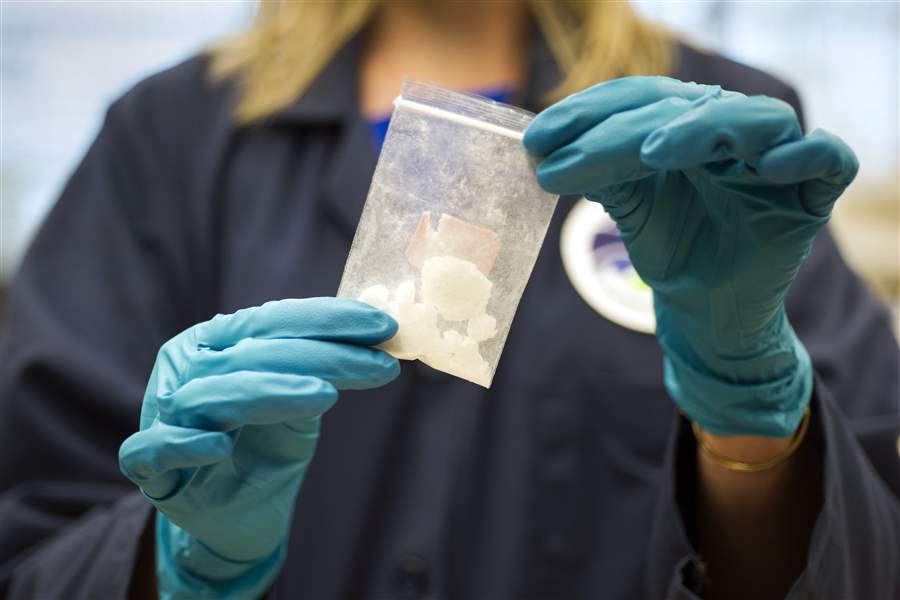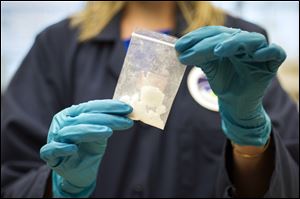
Opioid death trends in area match state
Fentanyl, other synthetics increasingly are to blame
9/3/2017
A bag of 4-fluoro isobutyryl fentanyl which was seized in a drug raid is displayed at the Drug Enforcement Administration (DEA) Special Testing and Research Laboratory. Unintentional drug overdoses killed 1,000 more people in Ohio in 2016 than the previous year, according to a report last week from the Ohio Department of Health.
ASSOCIATED PRESS
A new report detailing the number of Ohioans who died of accidental overdoses in 2016 confirms that trends seen last year in Lucas County and northwest Ohio are mirrored across the state — namely that the total deaths continue to rise, as does the prevalence of deadly synthetic opioids such as fentanyl and carfentanil.
Unintentional drug overdoses killed 1,000 more people in Ohio in 2016 than the previous year — 4,050 compared with 3,050 in 2015 — according to a report last week from the Ohio Department of Health.

A bag of 4-fluoro isobutyryl fentanyl which was seized in a drug raid is displayed at the Drug Enforcement Administration (DEA) Special Testing and Research Laboratory. Unintentional drug overdoses killed 1,000 more people in Ohio in 2016 than the previous year, according to a report last week from the Ohio Department of Health.
Fentanyl and related drugs were involved in 58.2 percent of all deaths, up from 37.9 percent in 2015. The powerful synthetic opioid, which is up to 50 times more potent than heroin, has sharply increased in recent years. It was the cause of just 4 percent of overdoses in Ohio in 2013.
Heroin deaths remained flat and prescription deaths declined for the fifth consecutive year, down to 564 — the fewest since 2009 — the report shows.
“The continued increase in opioid-related deaths reaffirms that we still have much work to do, but Ohio is seeing important progress in reducing the number of prescription opioids available for abuse and prescription-related overdose deaths,” said a statement from Dr. Mark Hurst, medical director of the Ohio Department of Mental Health and Addiction Services and interim medical director for the state health department. “This progress is significant because prescription opioid abuse is frequently a gateway to heroin and fentanyl use later on.”
A new rule took effect Thursday limiting doctors to prescribing seven days worth of opioids for adults to treat acute pain; prescriptions for children are limited to five days. Gov. John Kasich announced the change in March.
Some of the highest death rates from 2011 to 2016 were in southwestern counties such as Butler and Montgomery counties, where death rates were 40.5 and 42.5 per 100,000 people, respectively.
In Lucas County, the death rate was 24.1 per 100,000 people, the highest in the region. It was 11.1 in Wood and 17.4 in Fulton, according to the report.

Toledo mayoral candidate Wade Kapszukiewicz, left, and John Clemons listen to Laurie Clemons speak about her son's death from opioid addiction. Kapszukiewicz says that as mayor of Toledo, he would join other communities in a lawsuit against "opioid manufacturers and distributors."
The 2016 Ohio numbers confirm what Toledo-area officials are seeing is also happening elsewhere.
A June report from the Lucas County Coroner’s Office revealed fentanyl, for the first time, is behind more overdose deaths than heroin in a 21-county region of northwest Ohio and southeast Michigan. The local figures show overall deaths continue to increase with the rise of potent and synthetic opioids that can be deadly in very small quantities.
The new report also affirms the local need for continued prevention and treatment efforts, said Scott Sylak, executive director of the Lucas County Mental Health and Recovery Services Board.
“We continue to invest in these strategies understanding that we have to be in it for the long haul,” he said.
He pointed to several new programs or services that began in Lucas County in recent months, including new inpatient detox centers at the University of Toledo Medical Center and Unison Health, ambulatory detox services at Zepf Center and New Concepts, and the Northwest Ohio Syringe Services needle exchange run through the Toledo-Lucas County Health Department.
“There isn’t an easy or quick answer,” he said. “These are very difficult social questions that don’t lend themselves well to a quick answer.”
If you or someone you know is seeking treatment options and other resources, visit helpwithheroin.com or call 419-213-6582.
Contact Lauren Lindstrom at llindstrom@theblade.com, 419-724-6154 or on Twitter @lelindstrom.